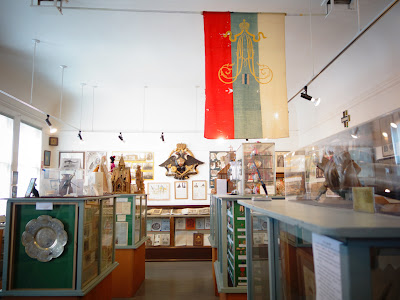Since last week, I have been in San Francisco, California, on the mission of applying from my Russian visa. So far, all is well and it should be ready by next week. In the interim, I have had the chance to discover the little corner of Russia that lives here in the City.
 |
| Dolls and ephemera of Russia. |
By chance, I discovered a small but well kept institute of Russian-Americans here, where you can visit the free and open to the public Museum of Russian Culture. With an intimate atmosphere and quiet hospitality, the space reminded me very much of the apartment museums of Saint Petersburg, the gallery is a wonderful discovery and escape from the American streets into a little corner of Russia. The museum features a well honed mixture of arts, crafts, history and local culture.
 |
| Inscription with peacocks. |
Perhaps the most amazing thing in the museum is an original White Army flag, authentically stained with blood of the counter revolutionaries, hanging discreetly in a corner amongst other textiles. Having a guide point out such details is what makes the expert set of eyes so useful when visiting small and detail-packed museums.
 |
| Tolstoy and historical documents. |
The gallery has its own semi-official tumblr blog Zolotoivek, which focuses on the Golden Years of Russian history, 1880-1940. I was lucky enough to have a personal tour of the museum from the blogs curator, who warmly and with informative passion showed me through the detailed cases and wall hangings that consist of the museum's collections. Since the 1970s, the place remains largely unchanged, and even includes a small private library of Russian books.
 |
| View of the Museum. |
Overall, I highly recommend any passer-bys, visitors and locals of the Bay Area to visit the Cultural Center. Since it relies only on volunteer work, any donations are highly appreciated. I personally love that such museums like this even continue to exist, fostering community and adding to the rich "salad bowl" of the United States that make the country so rich for discovering the pockets of immigrants that add to the vibrancy of the nation as a whole.


